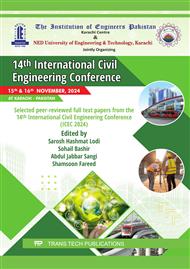[1]
Ngowi, A., et al., The globalisation of the construction industry—a review. Building and environment, 2005. 40(1): pp.135-141.
Google Scholar
[2]
Lima, L., et al., Sustainability in the construction industry: A systematic review of the literature. Journal of Cleaner Production, 2021. 289: p.125730.
Google Scholar
[3]
Khalid, A., R.A. Khushnood, and S.A. Memon, Pyrolysis as an alternate to open burning of crop residue and scrap tires: Greenhouse emissions assessment and mechanical performance investigation in concrete. Journal of Cleaner Production, 2022. 365: p.132688.
DOI: 10.1016/j.jclepro.2022.132688
Google Scholar
[4]
Abdulfattah, O., et al., Experimental evaluation of using pyrolyzed carbon black derived from waste tires as additive towards sustainable concrete. Case Studies in Construction Materials, 2022. 16: p. e00938.
DOI: 10.1016/j.cscm.2022.e00938
Google Scholar
[5]
Gao, T., et al., Analysis of material flow and consumption in cement production process. Journal of Cleaner Production, 2016. 112: pp.553-565.
DOI: 10.1016/j.jclepro.2015.08.054
Google Scholar
[6]
Schneider, M., Process technology for efficient and sustainable cement production. Cement and concrete research, 2015. 78: pp.14-23.
DOI: 10.1016/j.cemconres.2015.05.014
Google Scholar
[7]
Schneider, M., et al., Sustainable cement production—present and future. Cement and concrete research, 2011. 41(7): pp.642-650.
DOI: 10.1016/j.cemconres.2011.03.019
Google Scholar
[8]
Neve, S., et al., Valorization of vetiver root biochar in eco-friendly reinforced concrete: mechanical, economic, and environmental performance. Materials, 2023. 16(6): p.2522.
DOI: 10.3390/ma16062522
Google Scholar
[9]
Annually, R.I., ASTM STANDARDS. 1995.
Google Scholar
[10]
IMARC, Tire Market Report by Design (Radial Market, Bias Market), End-Use (OEM Market, Replacement Market), Vehicle Type (Passenger Cars, Light Commercial Vehicles, Medium and Heavy Commercial Vehicles, Two Wheelers, Three Wheelers, Off-The-Road (OTR)), Distribution Channel (Offline, Online), Season (All Season Tires, Winter Tires, Summer Tires), and Region 2024-2032. 2024.
DOI: 10.1016/b978-0-12-820685-0.00022-3
Google Scholar
[11]
Dai, X., et al., Pyrolysis of waste tires in a circulating fluidized-bed reactor. Energy, 2001. 26(4): pp.385-399.
DOI: 10.1016/s0360-5442(01)00003-2
Google Scholar
[12]
JIANG, Z., et al., Review of pyrolysis for waste tires and research prospects of pyrolysis products. Chemical Industry and Engineering Progress, 2021. 40(1): p.515.
Google Scholar
[13]
Zhang, X., et al., Vacuum pyrolysis of waste tires with basic additives. Waste Management, 2008. 28(11): pp.2301-2310.
DOI: 10.1016/j.wasman.2007.10.009
Google Scholar
[14]
Cheng, W., Carbon Sequestration In Concrete. 2016.
Google Scholar
[15]
Tan, K.-H., et al., Biochar as a partial cement replacement material for developing sustainable concrete: An overview. Journal of Materials in Civil Engineering, 2021. 33(12): p.03121001.
DOI: 10.1061/(asce)mt.1943-5533.0003987
Google Scholar
[16]
Gupta, S., H.W. Kua, and S.D. Pang, Biochar-mortar composite: Manufacturing, evaluation of physical properties and economic viability. Construction and Building Materials, 2018. 167: pp.874-889.
DOI: 10.1016/j.conbuildmat.2018.02.104
Google Scholar
[17]
Gupta, S., H.W. Kua, and H.J. Koh, Application of biochar from food and wood waste as green admixture for cement mortar. Science of The Total Environment, 2018. 619-620: pp.419-435.
DOI: 10.1016/j.scitotenv.2017.11.044
Google Scholar
[18]
Bungey, J.H. and M.G. Grantham, Testing of concrete in structures. 2006: Crc Press.
Google Scholar
[19]
Wedatalla, A.M., Y. Jia, and A.A. Ahmed, Curing Effects on High‐Strength Concrete Properties. Advances in Civil Engineering, 2019. 2019(1): p.1683292.
DOI: 10.1155/2019/1683292
Google Scholar
[20]
Han, W., D. Han, and H. Chen, Pyrolysis of waste tires: a review. Polymers, 2023. 15(7): p.1604.
DOI: 10.3390/polym15071604
Google Scholar
[21]
Mentes, D., et al., Investigation of gaseous and solid pollutants emitted from waste tire combustion at different temperatures. Waste Management, 2022. 149: pp.302-312.
DOI: 10.1016/j.wasman.2022.06.027
Google Scholar


